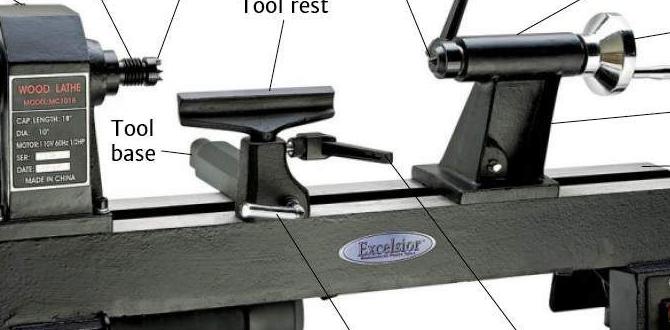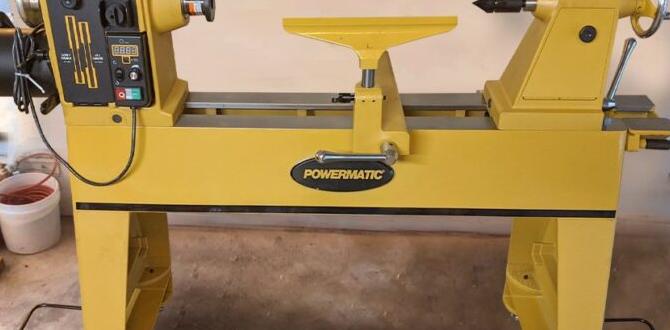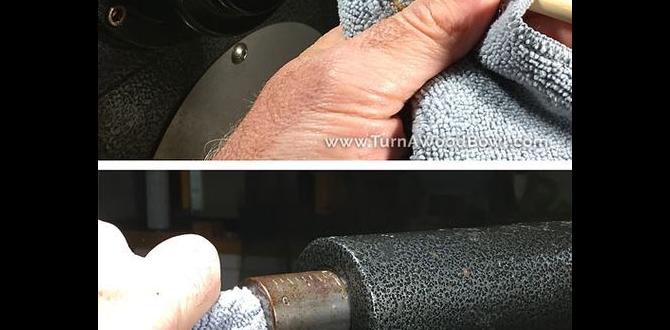A wood lathe is an indispensable tool in the realm of woodworking, enabling the transformation of raw timber into intricately shaped and finely finished pieces. This sophisticated machine operates by rotating the workpiece against fixed cutting tools, facilitating a range of operations such as turning, sanding, and chiseling. Understanding the mechanics behind a wood lathe, including aspects like spindle speed, tool rest positioning, and grain orientation, is essential for both novice and experienced craftsmen. As we delve deeper into the nuances of what a wood lathe encompasses, you’ll discover how mastering this tool can unlock new dimensions of creativity in your woodworking projects.
What Is Wood Lathe: Understanding Its Purpose And Use
A wood lathe is a versatile tool essential for woodworking enthusiasts and professionals alike. It is used to shape, cut, and finish wood by rotating the material against cutting tools. Understanding how a wood lathe operates, its components, and various techniques can significantly enhance one’s woodworking skills. This briefing provides an overview of the wood lathe’s functions, benefits, and potential projects, offering valuable insights for anyone interested in delving deeper into the art of woodturning and the creativity it unlocks.Types of Wood Lathes
Description of different types (benchtop, floorstanding, mini, etc.). Key features and capabilities of each type.
Wood lathes come in various shapes and sizes, each designed for specific needs. Here are some main types:
- Benchtop Lathes: Compact and perfect for small projects. They are portable and ideal for beginners.
- Floorstanding Lathes: Larger and more powerful, these are suitable for professional woodturners.
They offer stability and can handle bigger pieces.
- Mini Lathes: Lightweight and easy to use, great for crafting small items like pens and bowls.
- Variable Speed Lathes: These allow users to adjust the speed for different projects, offering better control.
Each type has unique features, catering to different skill levels and project sizes.
Basic Components of a Wood Lathe
Detailed breakdown of essential parts (bed, headstock, tailstock, etc.). Function and importance of each component.
A wood lathe is made up of several essential parts, each playing a vital role. The bed keeps everything stable, like a strong foundation for a house. The headstock holds the motor and keeps the wood spinning, while the tailstock helps support the other end of the wood piece.
Without these, your wood might just sit there, looking pretty, but ultimately useless. Think of it as a dance party; everyone needs their space to twirl and whirl!
| Component | Function |
|---|---|
| Bed | Provides stability |
| Headstock | Houses the motor and spins the wood |
| Tailstock | Supports the other end of the wood |
How to Choose the Right Wood Lathe
Factors to consider based on skill level and project types. Brand recommendations and comparison of features.
Choosing the right wood lathe depends on several factors. First, consider your skill level. Beginners may need a simpler model, while advanced users can opt for more features. Next, think about the types of projects you want to create—small items like pens or larger furniture pieces.
- For beginners: Look for user-friendly controls.
- For advanced users: Choose lathes with variable speeds and attachments.
- Popular brands: Jet, Grizzly, and Laguna.
Compare features such as power, swing capacity, and materials. This will help you find the best fit for your work.
Setting Up a Wood Lathe
Stepbystep guide to assembly and setup. Safety measures and best practices during setup.
Assembling a wood lathe requires careful steps. Start by placing the lathe on a stable surface. Make sure the power source is secure.
Next, connect the tailstock and headstock according to the manual. Use tools to tighten all screws and bolts properly. Always wear safety goggles during this process to protect your eyes from debris.
- Check for loose parts.
- Clear the workspace of clutter.
- Ensure the lathe is level.
Following these safety measures will help avoid accidents.
Keep fingers away from moving parts. Lastly, read the manufacturer’s instructions closely.
Tools and Accessories for Wood Lathes
List of essential tools (chisels, gouges, etc.). Recommended accessories (faceplates, chucks, etc.).
Working with a wood lathe requires several essential tools and accessories to create beautiful pieces. Here’s what you need:
- Chisels: These are great for shaping wood smoothly.
- Gouges: They help carve out deeper shapes and designs.
- Parting tools: Useful for cutting and defining edges.
For accessories, consider these items:
- Faceplates: They secure your workpiece for better stability.
- Chucks: Ideal for gripping various shapes with ease.
- Tool rests: They support your tools during work.
Common Wood Turning Projects
Ideas for projects suitable for beginners and experienced users. Examples and descriptions of popular wood turning items.
Wood turning offers a wide variety of exciting projects. Beginners can start with simple items such as:
- Spindles: These are narrow, long pieces perfect for practice.
- Bowls: Easy to shape and can be functional or decorative.
- Coasters: Small and quick to make, great for gifts.
Experienced users might enjoy crafting:
- Furniture legs: Adding character to tables and chairs.
- Vases: Beautiful pieces that can hold flowers.
- Intricate sculptures: Unique art that showcases skill.
Each project enhances creativity and technique. Choose one that excites you!
Maintenance of a Wood Lathe
Importance of regular maintenance. Tips for cleaning and maintaining different components.
Taking care of your wood lathe is like brushing your teeth—neglect it, and things will get messy! Regular maintenance keeps your lathe running smoothly and helps you avoid those surprise trips to the repair shop. Cleaning the bed, the tailstock, and the drive components is crucial.
A dust-free surface means less friction, and nobody likes friction! Here are some simple tips to keep your lathe shiny:
| Component | Maintenance Tips |
|---|---|
| Bed | Wipe with a soft cloth after each use. |
| Tailstock | Check for chips and clean with compressed air. |
| Drive System | Oil the bearings regularly to keep them purring. |
Follow these tips, and your lathe will be as happy as a beaver in a woodshop!
Advanced Wood Turning Techniques
Explanation of more complex turning methods. Resources for learning advanced techniques (books, online courses, etc.).
Once you’ve mastered the basics, you can dive into advanced woodturning techniques! These include methods like hollowing, segmented turning, and even captive ring techniques. Each one adds flair and complexity to your projects.
Finding resources is easy. Check out books like “The Complete Manual of Woodworking” or take online courses from sites like YouTube and Skillshare. You’ll turn from a novice to a wood wizard in no time!
| Resource Type | Recommended Title |
|---|---|
| Book | The Complete Manual of Woodworking |
| Online Course | Skillshare Woodturning Essentials |
| Video Tutorials | YouTube Woodturning Channels |
Frequently Asked Questions about Wood Lathes
Answers to common queries and misconceptions. Troubleshooting tips for users.Many people have questions about wood lathes. Here are some common queries and misconceptions:
- What is a wood lathe used for? It’s mainly to shape wood into various forms.
- Are all wood lathes the same? No, they come in different sizes and styles for specific tasks.
- Is it hard to use a wood lathe? With practice, it becomes easier!
If you experience issues, try these troubleshooting tips:
- Check that the wood is secured properly before starting.
- Ensure the tool is sharp for a clean cut.
- Adjust the speed if the lathe isn’t working smoothly.
Conclusion
In summary, a wood lathe is an essential tool for woodworkers, enabling them to create intricate designs and shapes through rotational turning. Understanding its components and functionality enhances both beginner and experienced artisans’ skills, opening up endless possibilities for creativity. By mastering the wood lathe, enthusiasts can transform raw wood into beautiful, functional pieces, elevating their craft to new heights.
FAQs
What Are The Basic Components Of A Wood Lathe And How Do They Function Together?The basic components of a wood lathe include the bed, headstock, tailstock, tool rest, and motor. The bed provides a sturdy base and alignment for the other components, while the headstock houses the motor and allows for the spindle to spin the workpiece. The tailstock can be adjusted to support the opposite end of the workpiece, providing stability, and the tool rest supports cutting tools as they are used to shape the wood. Together, these components work in unison to enable precise and controlled shaping of wood into various forms.
What Types Of Projects Can Be Created Using A Wood Lathe?A wood lathe can be used to create various projects, including spindle turning for furniture legs, decorative bowls, and intricate spindles for railings. Woodturners can also craft items like pens, lamp bases, and custom handles for tools and kitchen utensils. Additionally, more artistic pieces such as wooden sculptures and hollow forms can be made. The versatility of a wood lathe allows for both functional and decorative projects in woodworking.
How Do You Properly Set Up And Operate A Wood Lathe For Beginners?To properly set up and operate a wood lathe for beginners, start by ensuring the lathe is placed on a sturdy, level surface and securely plugged in. Install the appropriate tools and workpieces by tightening the chuck and adjusting the tailstock for proper alignment. Before starting the lathe, check that all tools are sharp and the speed is set according to the material being turned. Always wear appropriate safety gear, such as goggles and gloves, and maintain a safe distance from the rotating workpiece while operating the lathe.
What Safety Precautions Should Be Taken When Using A Wood Lathe?When using a wood lathe, always wear appropriate personal protective equipment, including safety glasses, dust masks, and ear protection. Ensure the workpiece is securely mounted and balanced before starting the lathe. Keep hands and tools clear of the rotating workpiece, and maintain a safe distance. Regularly check the machine for proper functioning and report any issues before use.
What Are The Differences Between Different Types Of Wood Lathes, Such As Mini Lathes And Full-Size Lathes?Mini lathes are smaller, more portable machines designed for lighter projects, making them ideal for beginners or those with limited workspace. They typically have lower horsepower and a limited swing capacity, suitable for turning smaller items like pens and bowls. Full-size lathes, on the other hand, offer greater power, larger swing capacities, and more stability, accommodating larger and more complex projects. Additionally, full-size lathes often come with more features and accessories, allowing for greater versatility in woodworking.
